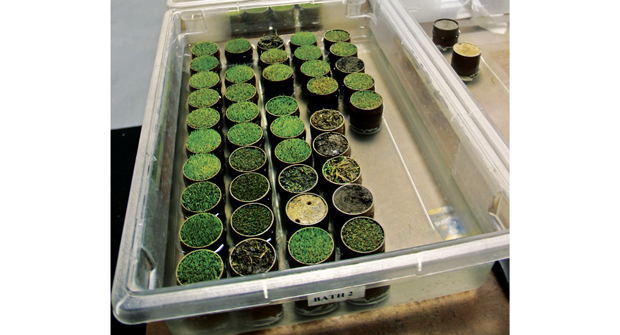
There’s a scene in the old Woody Allen film Sleeper in which his character awakens 200 years hence and learns from a scientist that fat, steaks, pies and hot fudge are all good for you, whereupon the scientist offers him a cigarette, claiming that it’s one of the healthiest things for your body.
No, I am not telling you to have a cigarette with a hot fudge sundae (the hot fudge sundae does sound enticing, however). The movie pokes fun at all manner of scientific shibboleths, but it reminds me that much of what I learned in school has been paved over with new information. In fact, I can recall one professor proclaiming that the purpose of college was teaching students how to learn on their own — learning how to learn, in other words.
Advances in plant pathology
A remarkable example is in the field of plant pathology. I have a text from my father’s turfgrass disease class back in the 1960s: Diseases of Turfgrass by Professor Couch at Penn State (upon which a very young Bobby Mann scribbled here and there with a ballpoint pen — naughty boy). The book describes a disease known as Ophiobolus patch, causing depressed, circular patches of blighted turfgrass.
This book published in 1962. As late as 1982, Ophiobolus patch was still being taught, at least at the Stockbridge School of Agriculture, where between eating too much pizza and drinking too much beer, I occasionally showed up to class.
Now ask yourself, have you ever heard of Ophiobolus patch? If you answered probably not, why might that be? Did the disease simply vanish? We should be so lucky, right?
No, what happened is that there was a marked increase in the knowledge of soilborne plant pathogens during the 1980s that resulted in the discovery of new fungi not previously known. Ophiobolus was renamed Gaeumannomyces, and the disease itself was renamed take-all patch. (Thank goodness for something simple, eh?) As a result of this research, we now have a series of diseases of turfgrass roots — Bermudagrass decline, necrotic ring spot, spring dead spot and summer patch — that more accurately describe root-infecting diseases of turfgrass.
Invest in your learning
So what, you may ask? I was reminded of this development when I attended the Turf Research Field Day at UMass Amherst, one of many such field days across the country. Apart from catching up with industry friends and enjoying a great barbecue lunch, field days afford you the opportunity to get up to date with the latest research in a way that you simply cannot achieve by reading about it.
You can’t beat having a graduate student or professor stand in the middle of a research plot and explain what’s happening. You get to see the results with your own eyes and speak with the researchers yourself. That kind of interaction sticks with you far better than just reading it in a book.
If you’re not plugged into this network of learning, I’m happy to help you out. The small amount of time you invest in stretching your knowledge will pay you back many times over when your customers need an expert to turn to when things go south in the landscape.

